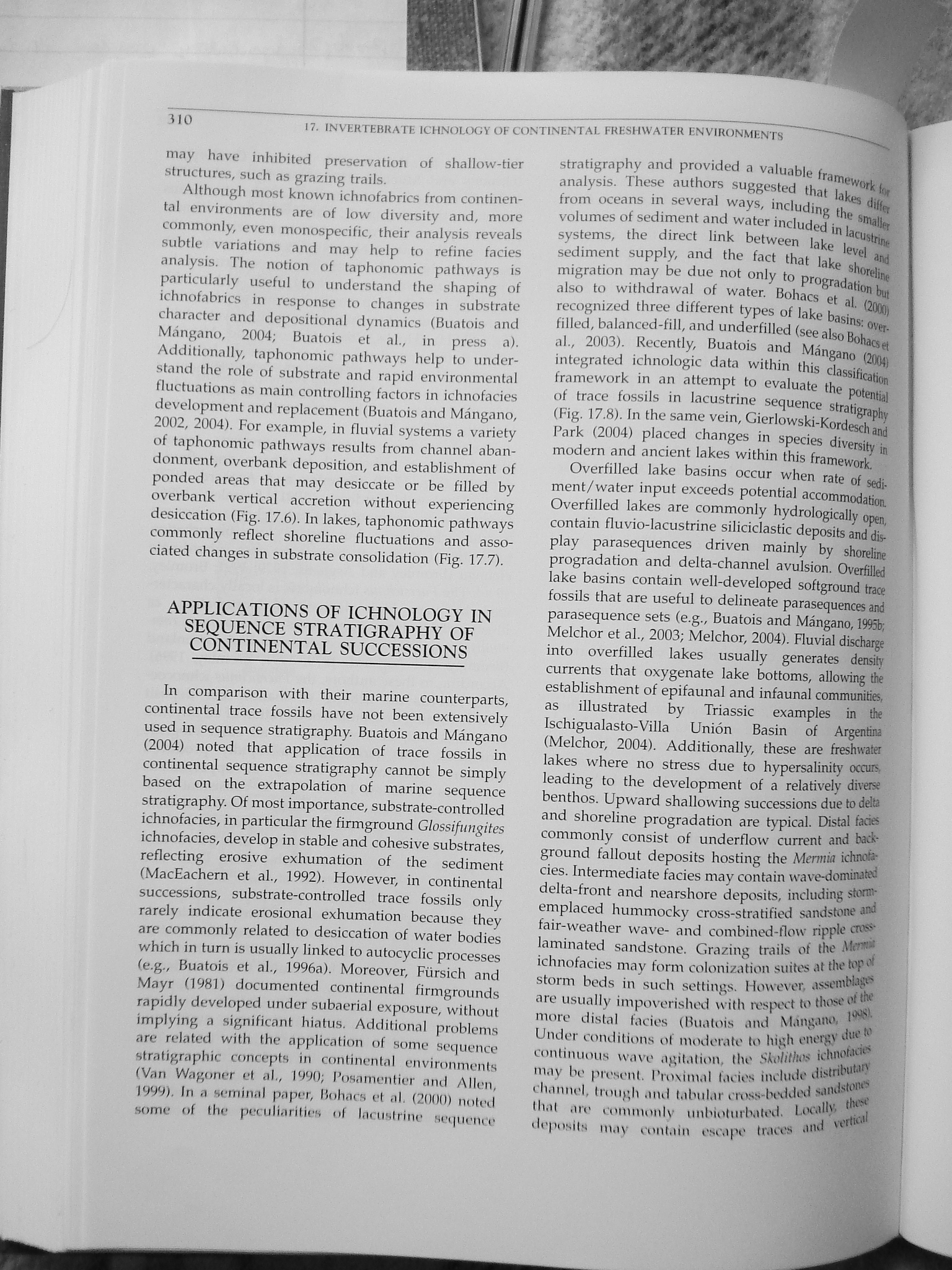dsc08832 (2)

310
17. INVERTEBRATE ICHNOLOGY OF CONTINENTAL FRESHWATER ENVIRONMENTS
may have inhibited preservation of shallow-tier struciures, such as grazing trails.
Although most known ichnofabrics from Continental environments are of Iow diversity and, morę commonly, even monospecific, their analysis reveals subtle variations and may help to refine fades analysis. The notion of taphonomic pathways is particularly useful to understand the shaping of ichnofabrics in response to changes in substrate character and depositional dynamics (Buatois and Mangano, 2004; Buatois et al., in press a). Additionally, taphonomic pathways help to understand the role of substrate and rapid environmental fluctuations as main controlling factors in ichnofades development and replacement (Buatois and Mangano, 2002, 2004). For example, in fluvial systems a variety of taphonomic pathways results from channel aban-donment, overbank deposition, and establishment of ponded areas that may desiccate or be filled by overbank vertical accretion without experiencing desiccation (Fig. 17.6). In lakes, taphonomic pathways commonly reflect shoreline fluctuations and asso-ciated changes in substrate consolidation (Fig. 17.7).
APPLICATIONS OF ICHNOLOGY IN SEQUENCE STRATIGRAPHY OF CONTINENTAL SUCCESSIONS
In comparison with their marinę counterparts, Continental tracę fossils have not been extensively used in sequence stratigraphy. Buatois and Mangano (2004) noted that application of tracę fossils in Continental sequence stratigraphy cannot be simply based on the extrapolation of marinę sequence stratigraphy. Of most importance, substrate-controlled ichnofades, in particular the firmground Glossifungites ichnofades, develop in stable and cohesive substrates, reflecting erosive exhumation of the sediment (MacEachem et al., 1992). However, in Continental successions, substrate-controlled tracę fossils only rarely indicate erosional exhumation because they are commonly related to desiccation of water bodies which in tum is usually linked to autocyclic processes (e.g., Buatois et al., 1996a). Moreover, Fiirsich and Mayr (1981) documented Continental firmgrounds rapidly developed under subaerial exposure, without implying a significant hiatus. Additional problems are related with the application of some sequence stratigraphic concepts in Continental environments (Van Wagoner et al., 1990; Posamentier and Allen, 1999). In a semłnal paper, Bohacs et al, (2000) noted some of the peculiarities of lacustrine sequcnce stratigraphy and provided a valuable framework Igr analysis. These authors suggested that lakes ćliffer from oceans in several ways, including the smaller volumes of sediment and water included in lacustrine systems, the direct link between lakę level and sediment supply, and the fact that lakę shoreline migration may be due not only to progradation bflt also to withdrawal of water. Bohacs et al. (2000) recognized three different types of lakę basins: over-filled, balanced-fill, and underfilled (see also Bohacs et al., 2003). Recently, Buatois and Mangano (2004) integrated ichnologic data within this classification framework in an attempt to evaluate the potential of tracę fossils in lacustrine sequence stratigraphy (Fig. 17.8). In the same vein, Gierlowski-KordfiS^i™ Park (2004) placed changes in species diversity in modern and ancient lakes within this framework. ; r Overfilled lakę basins occur when ratę of sediment/ water input exceeds potential accommodatm Overfilled lakes are commonly hydrologically open, contain fluvio-lacustrine silidclastic deposits and display parasequences driven mainly by shoreline progradation and delta-channel avulsion. Overfilled lakę basins contain well-developed softground tracę fossils that are useful to delineate parasequences and parasequence sets (e.g., Buatois and Mangano, 1995b; Melchor et al., 2003; Melchor, 2004). Fluvial discharge into overfilled lakes usually generates densiły currents that oxygenate lakę bottoms, allowing the establishment of epifaunal and infaunal communife, as illustrated by Triassic examples in the Ischigualasto-Villa Union Basin of Argentma (Melchor, 2004). Additionally, these are freshwate lakes where no stress due to hypersalinity occurs. leading to the development of a relatively divers benthos. Upward shallowing successions due to delta and shoreline progradation are typical. Distal fades commonly consist of underflow current and baek* ground fallout deposits hosting the Mermia ichnofe* cies. Intermediate fades may contain wave-dominated delta-front and nearshore deposits, including storm-emplaced hummocky cross-stratified sandstone and fair-weather wave- and combined-flow ripple cross* laminated sandstone. Grazing trails of the Afera* ichnofacies may form colonization suites at the tapof storm beds in such settings. However, assemblages are usually impoverished with respect to those ot the morę distal facies (Buatois and Mangano, lWk Under conditions of moderate to high energy due to continuous wave agitation, the $kolitho> ichnofades may be prosent. Proximal facies include distributary channel, trough and tabular criws-bedded sandstones that are commonly unbioturhaled. Locally these deposits may contain escape traces and wrtical
Wyszukiwarka
Podobne podstrony:
dsc08836 (2) i16 17. INVERTEBRATE ICHNOLOGY OF CONTINENTAL FRESHWATER ENVIRONMENTS are remarkably si
dsc08836 (2) i16 17. INVERTEBRATE ICHNOLOGY OF CONTINENTAL FRESHWATER ENVIRONMENTS are remarkably si
dsc08809 (2) 286 17. INYERTEBRATE ICHNOLOGY OF CONTINENTAL FRESHWATER EN VIRONMENTS assemblages that
dsc08808 (2) C H A P T E R17Irwertebrate Ichnology of Continental Freshwater EnvironmentsLuis Albert
dsc08813 (2) TABLE 17.1 Sunmumted Charactcrlstlcs, Ichnotaxonomic Composition and Environmental Impl
dsc08817 (3) TABLE 17.2 Seleeted Occurronecs of Flimal ichnofaunas. Only Papers that Combined Ichnot
dsc08810 (2) 287 ICHNOLOGY OF FLUVIAL SYSTEMS Coprinisphuera ichnofacies FIGURĘ 17.1 Ichnofacies mod
dsc08811 (2) ICHNOLOGY OF FLUYIAL SYSTEMS Coprimsphaera ichnofacies FIGURĘ 17.1 Ichnofades model of
dsc08829 (2) INYERTEBRATE ICHNOLOGY OF CONTINENTAL FRESHWATER ENVJRONMENTSBeaconrtes -Taenidium
dsc08829 (2) INYERTEBRATE ICHNOLOGY OF CONTINENTAL FRESHWATER ENVJRONMENTSBeaconrtes -Taenidium
dsc08828 (2) 308 7. INYERTEBRATE fCHNOLOGY OF CONTINENTAL FRESHWATER ENYIRONMENTS Beaconites -Taenid
dsc08828 (2) 308 7. INYERTEBRATE fCHNOLOGY OF CONTINENTAL FRESHWATER ENYIRONMENTS Beaconites -Taenid
dsc08823 (2) TABLE 17.2 (Continued) Age Cretaceous Stnitigniphic Unit &
dsc08826 (2) ICHNOLOCJY OF LACUSTRINE SYSTEMS 299 Brncken and Pieard, I 984; Squiros and Advocate, 1
dsc08823 (2) TABLE 17.2 (Continued) Age Cretaceous Stnitigniphic Unit &
dsc08826 (2) ICHNOLOCJY OF LACUSTRINE SYSTEMS 299 Brncken and Pieard, I 984; Squiros and Advocate, 1
Subiektywne teorie wiedzy (andragogów) jako... 17 Subjective thcories of knowledge (of andragogucs)
img012 3 17. In winter months loads stacked outside may be covered in ice and snów, the effect of&nb
więcej podobnych podstron